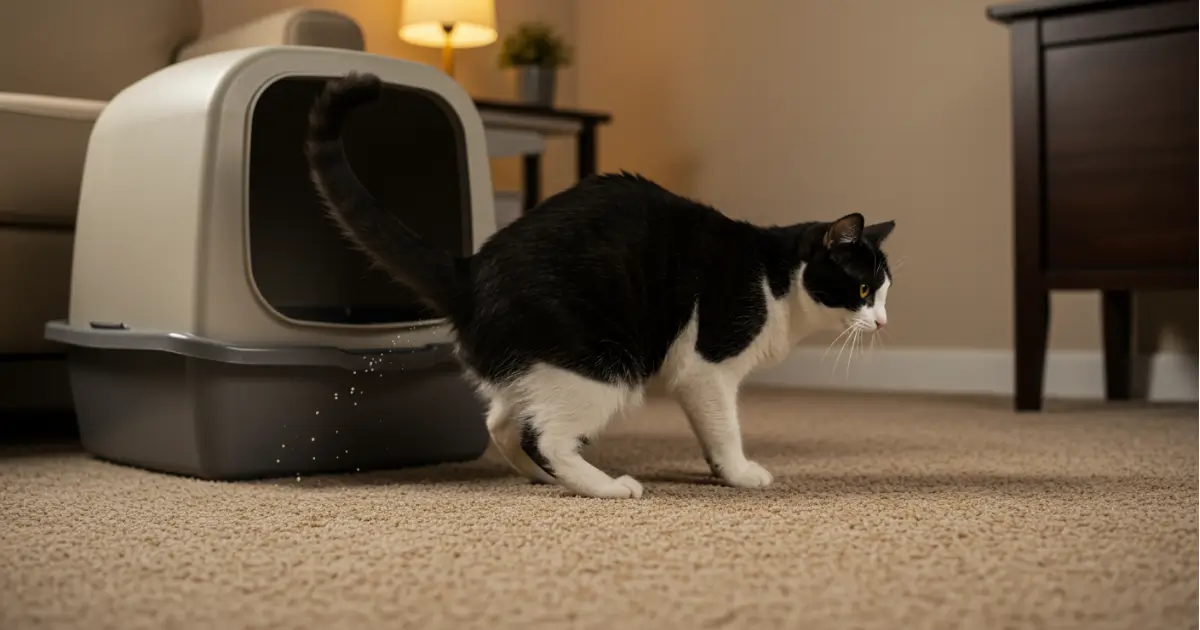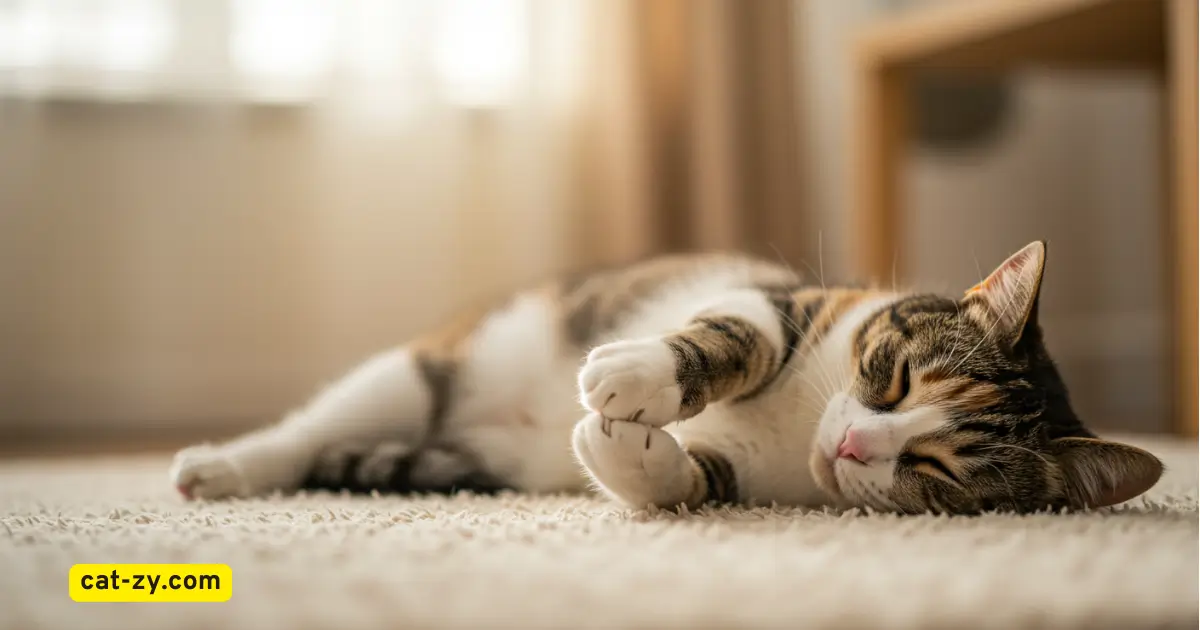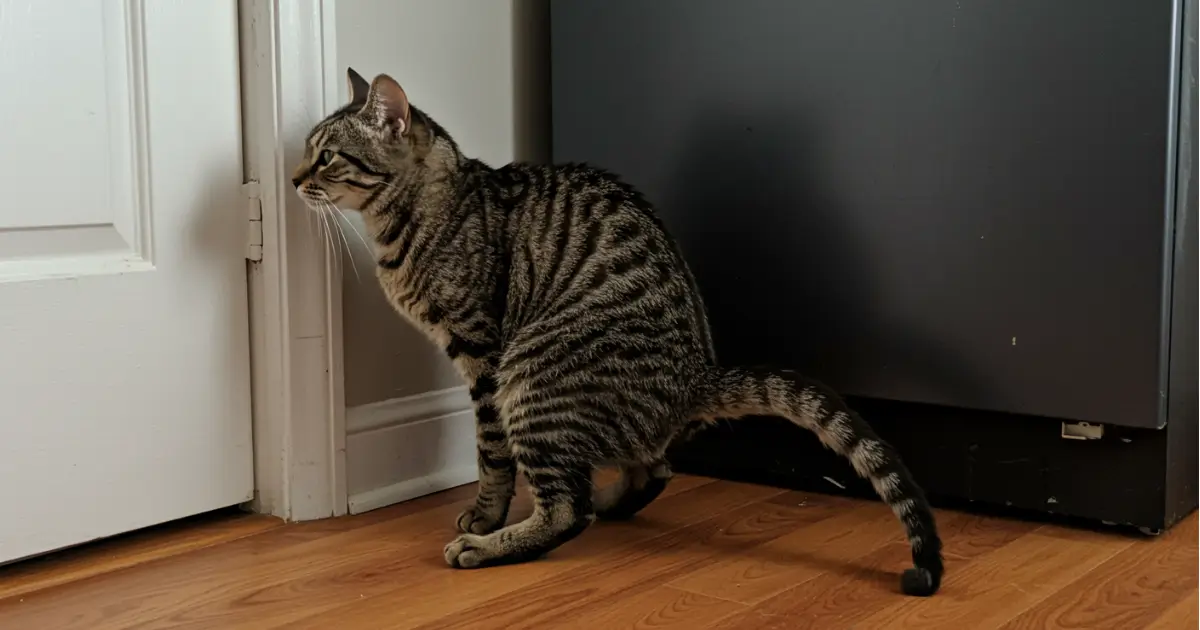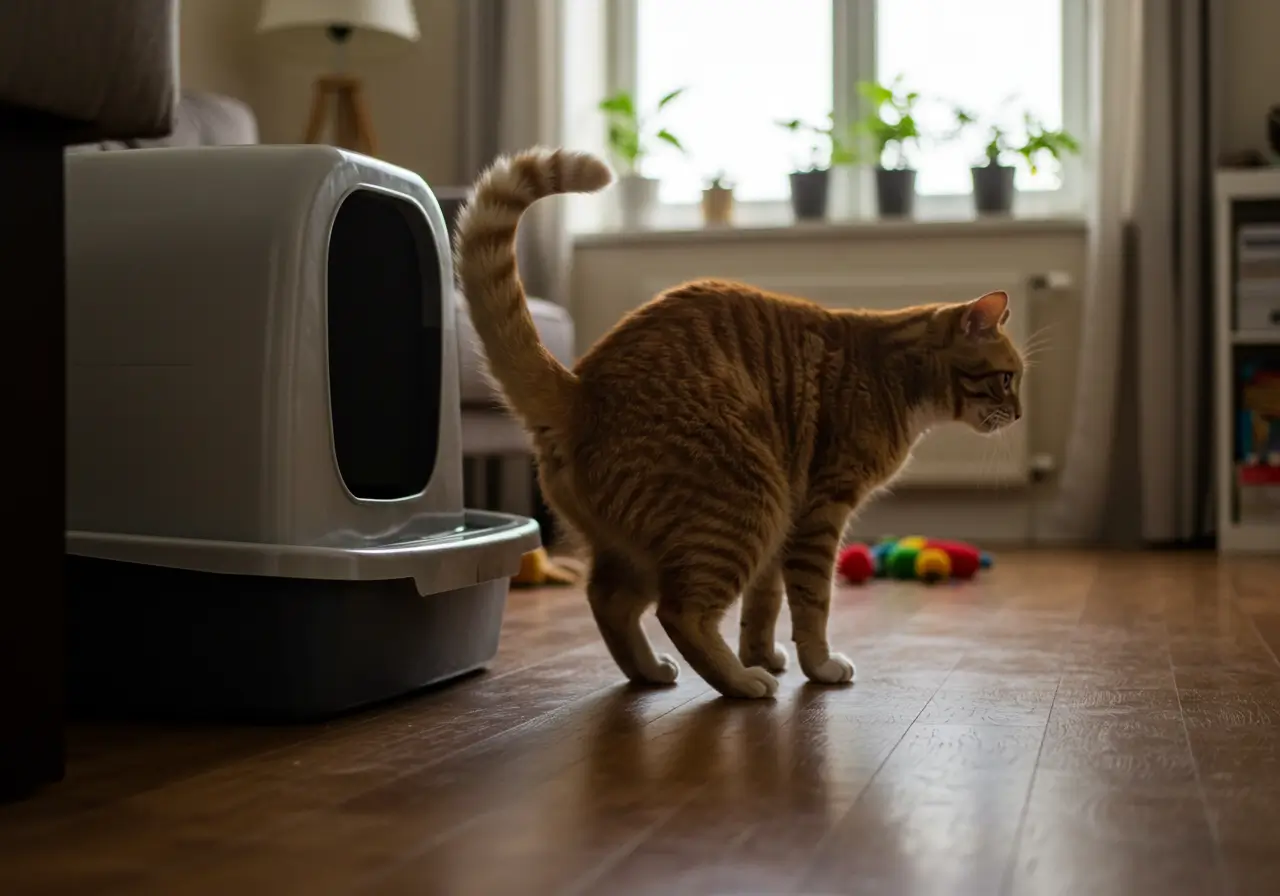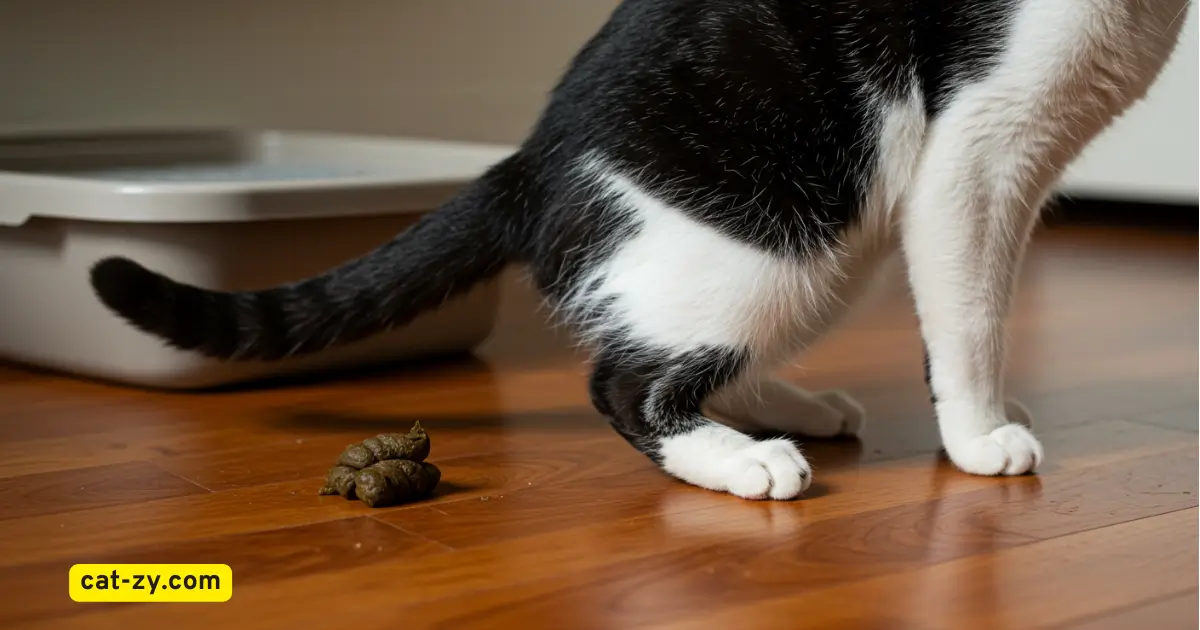Cat Urinating Outside Litter Box? 7 Fixes to Stop It Fast!
One in ten cats face litter box issues each year. This is a common reason for vet visits. If your cat is avoiding the litter box, it’s a sign of something. It could be health problems, stress, or changes at home.
Most cat owners deal with this issue often. However, by taking the proper steps, you can overcome it. Cat urinating outside litter box is not about being naughty. It usually means your cat is in pain, stressed, or upset by changes.
This behavior can start suddenly, even if your cat has always used the box. Every accident has a reason. It could be a health issue, marking territory, or not liking the litter. Finding and fixing the cause stops the problem.
Table of Contents
Key Takeaways
- Inappropriate elimination often signals health issues like urinary tract infections or kidney disease.
- Stress from changes in home environment or routine can trigger cat urinating outside the litter box.
- Ignoring the problem risks worsening medical conditions or reinforcing bad habits.
- Age-related decline in mobility or senses may make the litter box less accessible.
- Most cat litter box problems resolve when medical, behavioral, and environmental factors are addressed together.
Common Reasons Why Your Cat Urinating Outside Litter Box
If your cat is peeing everywhere, finding the reason is key. We’ll look at the main causes of feline inappropriate elimination and cat behavior issues.
Medical Issues That Cause Inappropriate Elimination
Health problems often lead to cats avoiding the litter box. Common issues include:
- https://www.amazon.com/Vets-Best-Supports-Supplements-Chewable/dp/B0002I9O8EUrinary tract infections (UTIs) causing pain or discomfort
- Kidney disease or diabetes altering bathroom habits
- Arthritis making it hard to access the litter box
Look for signs like frequent trips to the box, crying while urinating, or blood in waste. These symptoms need quick vet care.
Stress and Anxiety Factors
Home changes can stress out your cat, leading to feline inappropriate elimination. Stressors include:
- New pets or family members
- Rearranged furniture or a moved litter box
- Loud noises or unfamiliar visitors
Stressed cats may pee in new spots, showing their discomfort.
Territory Marking vs. Inappropriate Urination
Spot the difference: territory marking is small urine spots on vertical surfaces. Cat peeing everywhere is larger accidents on floors. Both are different cat behavior issues. Marking is about social stress, while elimination issues might be health or litter box problems.
Age-Related Changes in Litter Box Habits
Elderly cats face physical challenges. Joint pain or cognitive decline can make climbing into boxes or remembering locations harder. Consider:
- Lower-entry litter boxes for mobility
- More accessible locations
- Odor-free litters for sensitive paws
Ignoring these needs may lead to avoidance behaviors.
Medical Conditions That Could Be Causing Your Cat Urinating Outside Litter Box
If your cat is cat urinating outside litter box or showing cat litter box problems, a health issue might be to blame. Many physical conditions disrupt normal bathroom habits. This makes the litter box feel unsafe or inaccessible. Here’s what to watch for:
Urinary Tract Infections and Crystals
UTIs and crystals in urine cause severe pain during urination. Cats may associate the litter box with discomfort. This leads them to avoid it altogether. Watch for:
- Straining without producing much urine
- Blood in urine
- Frequent trips to the box with little result
Kidney Disease and Diabetes
Conditions like kidney disease force the body to flush toxins through increased urination. Diabetic cats drink more, leading to accidents when they can’t reach the box quickly. Signs include:
- Drinking excessively
- Urinating larger amounts
- Lethargy or weight loss
When to Seek Veterinary Care
Never ignore sudden changes in litter box use. Seek immediate care if your cat shows:
- No urination for 12+ hours (a medical emergency)
- Vomiting paired with litter box avoidance
- Weakness or loss of appetite
Untreated medical issues worsen cat behavior issues. But early care can restore normal habits. Always rule out health problems first—behavior fixes won’t work if pain or illness is the root cause.
How to Create the Ideal Litter Box Environment
Cat litter box problems often come from setups that don’t meet your cat’s needs. To stop cats from peeing in the house, start by ensuring you have enough boxes. Follow the n+1 rule: provide one more litter box than the number of cats in your home. A single cat needs two boxes; two cats require three, and so on. This reduces competition and stress.
- Placement matters most. Place boxes in quiet, low-traffic areas away from food or water. Avoid basements with loud pipes or litter boxes near entryways.
- Size is critical. Most standard boxes are too small. Choose a pan at least 1.5x your cat’s body length. Large cats or kittens need extra space to dig and turn comfortably.
- Cleanliness is non-negotiable. Scoop solids daily and fully clean boxes weekly with unscented soap. Lingering odors trigger avoidance, leading to cat peeing outside the litter box.
Avoid common pitfalls like overcrowding boxes in one room or using covered boxes that trap smells. Cats also dislike plastic liners—many refuse boxes with them. Test different litters (clumping, silica, or natural) to find your cat’s preference. A “litter box preference test” involves setting out multiple options side by side to observe choices.
For cats resisting changes, introduce new boxes or litter gradually. Mix old and new litter for a week before switching fully. Consistency reduces stress-driven accidents. By addressing these factors, you tackle the root of how do you stop cats from peeing in the house and create an environment that respects their natural habits.
Behavioral Solutions to Stop Cats From Peeing Everywhere
Fixing your cat’s litter box problems often means changing their behavior. These cat behavior solutions aim to lower stress, stop unwanted marking, and encourage good habits. First, find out what causes the problem and then use methods that fit your cat’s needs.
Using Pheromone Products to Reduce Marking
Synthetic pheromones mimic the calming signals cats make naturally. Products like Feliway or Comfort Zone release calming pheromones to help with anxiety-driven cat marking territory. Put diffusers in places where your cat likes to hang out. Using them for 30 days can really help.
Environmental Enrichment Techniques
Make your home more interesting to keep your cat from peeing out of stress. Try these ideas:
- Vertical space: Cat trees and shelves give them safe spots to watch the world.
- Play areas: Playing with toys like feather wands every day helps them release energy.
- Scratching posts: These help redirect their marking instincts to the right places.
Working With a Cat Behaviorist
If you can’t solve the problem yourself, get help from a cat behaviorist. They will look at your home, your cat’s history, and how they interact with you. Look for experts certified by the International Association of Animal Behavior Consultants (IAABC).
Training Methods That Actually Work
Punishment makes things worse, but positive reinforcement builds trust. Here are some effective methods:
- Give treats when your cat uses the litter box.
- Use scratch mats or food puzzles to cover problem spots.
- Avoid yelling or spraying water—it only makes things worse.
“Cats don’t ‘pee out of spite’—their behaviors stem from stress or environmental needs,” says Dr. Jane Bennett, a feline behavior specialist. “Address root causes, not just symptoms.”
Using these methods along with regular cleaning (covered in Section 6) makes a complete plan to stop cats from peeing. Remember, it takes time and effort to change your cat’s habits.
Effective Cleaning Methods to Remove Cat Urine and Prevent Remarking
To get rid of cat urine smells and stains, you need more than just cleaning. Using cat urine cleaning tips helps keep your home smelling fresh. Enzymatic cleaners are key because they break down urine’s organic parts, stopping cats from coming back.
Enzymatic Cleaners: Why They Work Best
Household cleaners might cover up smells but don’t get rid of urine proteins. Products like Nature’s Miracle or Simple Solution do. Apply them to stains, wait as directed, and might need to do it again for tough spots.
Cleaning Different Surfaces
- Carpet: Act fast by blotting stains with paper towels. Mix the cleaner with water, apply, and soak. Then, rinse well to avoid any leftover residue.
- Furniture: Use a spray enzymatic cleaner on upholstery. Test it first on a hidden spot. For tough stains, steam cleaning is best—but avoid using too much heat.
- Hard Floors: Clean with a damp cloth and enzymatic cleaner. Finish with a vinegar-water mix to get rid of any leftover cleaner.
Preventing Future Accidents
To stop cats from marking again, use smart deterrents. Cover problem spots with aluminum foil or double-sided tape. Cats don’t like the feel. Also, try Feliway diffusers for calming scents. If it keeps happening, block off the area for a while.
By following these steps and using how do you stop cats from peeing in the house tips, you can solve the problem. Keep up with cleaning and using deterrents. This way, your cat will learn to avoid the area, not use it as a bathroom.
Conclusion: Creating a Harmonious Home for You and Your Cat
Solving litter box problems starts with knowing what your cat needs. If your cat won’t use the litter box, check for health issues first. Once health is okay, make their space better to stop cats from peeing in the wrong places.
Simple things like clean litter, quiet spots, and more boxes can help a lot.
Using cat behavior solutions and being consistent helps lower stress. Keep an eye on patterns and use pheromone sprays or fun play to calm them down. Regular vet visits and patience are essential. Most cats get better when their physical and emotional needs are met.
Preventing cat marking means finding and fixing the main problem. It could be health, stress, or feeling territorial.
Start with small steps like daily cleaning and slow changes to build trust. Celebrate every little success and don’t punish. By focusing on your cat’s comfort and listening to them, you can make a peaceful home. With the right steps, you and your pet can have a stronger bond.
FAQ
Why is my cat urinating outside the litter box?
Cats may pee outside the box for many reasons. These include health problems, stress, marking territory, or getting older. Finding the main cause is key to fixing the problem.
How can I stop my cat from peeing everywhere?
First, check if your cat is healthy by seeing a vet. Then, make the litter box area perfect. You can also try using pheromone products and making your cat’s space more interesting.
What are some common cat behavior issues related to inappropriate elimination?
Cats might pee outside the box due to stress, like moving, marking territory, or getting older. These changes can make it hard for them to use the litter box.
How do I address my cat’s territorial marking?
To stop territorial marking, use synthetic pheromone products. Also, make sure there are enough litter boxes around your home. Place them in spots where your cat feels safe.
What cleaning tips can I use for cat urine?
Use enzymatic cleaners to get rid of cat urine smells. Don’t use regular cleaners, as they might not work. Always follow the instructions for the right use on different surfaces.
How many litter boxes should I have?
You should have one litter box for each cat plus one more. This ‘n+1’ rule helps avoid fights and gives cats choices for where to go.
When should I seek veterinary care for my cat’s litter box issues?
If your cat shows signs of pain, like straining, blood in urine, or pees too much, see a vet. These signs could mean serious health problems.
What litter types do cats prefer?
Cats like unscented clumping litter, as it feels like the outdoors. Try different litters to see what your cat likes best. If changing, do it slowly.
Can I train my cat not to pee in the house?
Instead of training, focus on making their environment better. Use positive rewards and solve any stress issues. This is more effective than traditional training.
How can I enrich my cat’s environment to reduce stress?
Give your cat places to climb, hide, play, and watch the outdoors safely. This can help reduce boredom and stress, which might cause them to avoid the litter box.

